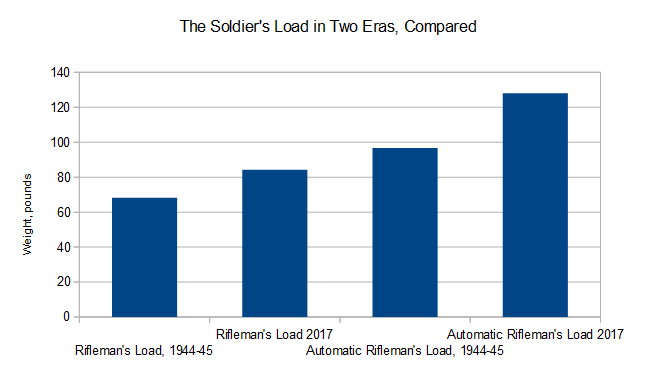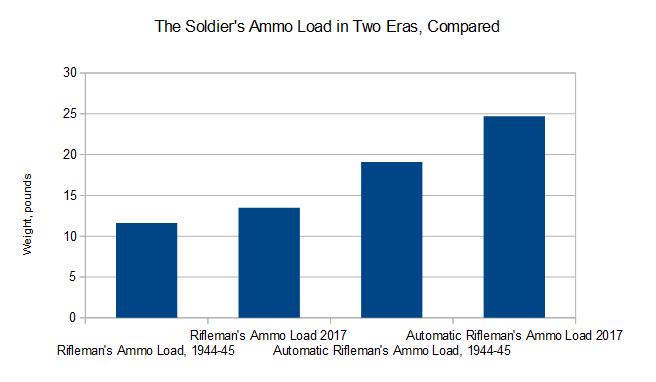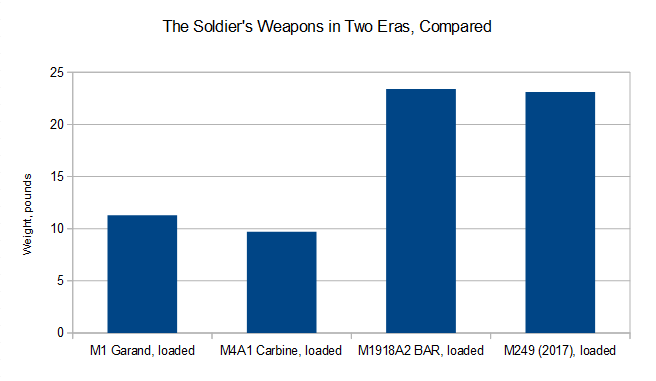With the soldier’s load growing beyond the bounds of reason, and the Army set to replace the M4 Carbine in some units with the new Interim Combat Service Rifle, questions have arisen about how the soldier’s burden has changed over time. In the comments section of several of my articles relating to these subjects, readers asked if I could compare the current soldier’s load with the soldier’s load from World War II, to see how they compare. As always, I am happy to oblige.
What we’ll be doing is comparing the Approach March Load (AML) of the Rifleman from 2017 versus the Rifleman of 1944-45, as well as the AML of the Automatic Rifleman (SAW gunner) of 2017 versus his counterpart of 1944-45.
First, we’ll refer back to The Modern Warrior’s Combat Load (2003) for detailed figures. That document gives a value of 95.7 pounds (43.4 kilograms) for the Rifleman’s AML. We also know from the recent GAO report on body armor that the soldier of 2017 is carrying a similar 96 pound load, although this load can increase significantly. Of that, 13.5 pounds (6.1 kilograms) is the ammunition (7 30 round magazines, and 200 linked rounds for the SAW), and 8.7 pounds (3.9 kilograms) is the fully equipped weapon (unloaded; with magazine inserted it is 9.7 pounds/4.4 kilograms).
According to the Modern Warrior’s Combat Load, the Automatic Rifleman of 2003 carried a load of 110.8 pounds (50.2 kilograms). However, that load has increased in the intervening years to 128 pounds (58 kilograms), as per the GAO report. Of these 128 pounds, a whopping 24.7 pounds (11.2 kilograms) is ammunition (800 linked rounds), and 18.9 pounds (8.6 kilograms) is the unloaded, fully equipped weapon (loaded it is 23.1 pounds, 10.5 kilograms).
For the soldier’s load during WWII, we will use the Soldier’s Load page over at 45thDivision.org. This provides a detailed breakdown of equipment carried at the time for both the Rifleman and the Automatic Rifleman (BAR gunner). According to the data on the website, the rifleman’s load during World War II was just 68.2 pounds (30.9 kilograms)! Of this, approximately 11.6 pounds (5.3 kilograms) was ammunition, and about 10.7 pounds (4.9 kilograms) was the M1 Garand with sling and cleaning kit (loaded, the rifle weighed 11.3 pounds/5.1 kilograms).
The Automatic Rifleman carried the notoriously heavy and cumbersome M1918A2 BAR, but even he comes out ahead of his modern counterpart by about 30 pounds. His total combat load was 84.3 pounds (38.2 kilograms), over eleven pounds lighter than the modern Rifleman’s combat load. Of this, 19.1 pounds (8.7 kilograms) was his ammunition, and 21.9 pounds (9.9 kilograms) was his BAR sans magazine and ammunition (with loaded magazine 23.4 pounds/10.6 kilograms).
The comparison makes it very clear: The Rifleman’s load today is nearly 30 pounds heavier than his counterpart’s load of 70 years ago, while the Automatic Rifleman’s load is over 40 pounds heavier than his WWII counterpart. Further, not only has the soldier’s total load increased thanks to the addition of body armor, night vision, new first aid equipment, and other innovations, but he is carrying more weight in weapons and ammunition, as well. Despite 70 years of innovation in lightweight weapons and ammunition, the soldier is still carrying more in weaponry than he did in 1945.
This drives home the old saw that soldiers are given “100 pounds of lightweight gear” – for the modern soldier this is quite literally true. Despite ammunition that per round is half the weight, and rifles that (when bare) weigh a fraction of their predecessors, the soldier today is burdened with so many additions, and such a substantial ammunition load that his predecessor from the European Theater seems to be taking it easy by comparison.
Thanks to bobk90 for referring me to 45thDivision.org for figures on the WWII soldier’s fighting load.
Post-publication note: Before this article was run, I noticed an error in the math… and then summarily forgot it. The error concerned which loads were being compared, as soldiers carry different loads at different times. In the US Army today, these are broken up into the Fighting Load (FL), Approach March Load (AML), and Emergency Approach March Load (EAML). The reader can think of these as “Light”, “Medium”, and “Heavy”, respectively. In the original iteration, I was effectively comparing the WWII EAML to the modern AML, which is obviously flawed. This is because the soldier’s load described on the 45th Division website is a winter load, which obviously includes heavier clothing, shelter, etc, which would not be carried in, say, summer in Afghanistan. The error has now been fixed.
 Your Privacy Choices
Your Privacy Choices



